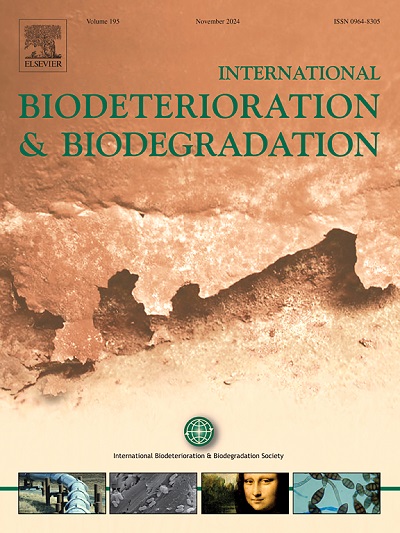hbcd在富集菌群中的生物降解途径
IF 4.1
2区 环境科学与生态学
Q2 BIOTECHNOLOGY & APPLIED MICROBIOLOGY
International Biodeterioration & Biodegradation
Pub Date : 2025-03-12
DOI:10.1016/j.ibiod.2025.106061
引用次数: 0
摘要
1,2,5,6,9,10-六溴环十二烷(hbcd)广泛应用于工业应用,对环境造成严重污染。以前,我们报道过hbcd在富集的微生物群落中的生物转化可能涉及降解者和其他分类群之间的相互作用。在本研究中,我们进一步调查了这些社区的这一现象。我们发现所有微生物群落在第24次转移时获得了hbcd的降解能力,降解率在12.8%到55.9%之间。hbcd的降解伴随着群落中可培养细菌的生长。Alcanivorax(81.14%,相对丰度)在SZH2-24微生物群落中保持优势地位。此外,亚转录组学分析显示,dadAH和dadBH是hbcd诱导的唯一脱卤酶基因。Alcanivorax和其他分类群的功能基因都可能参与下游生物降解途径。脱溴产物可能被苯酚2-单加氧酶(Alcanivorax)、甲苯甲基单加氧酶电子转移组分(菌丝微生物)、槲皮素2,3-双加氧酶(菌丝微生物和Alcanivorax)和4,5- dopa双加氧酶外二醇(Alcanivorax)氧化、水解和环裂解。随后,环裂解产物可能通过脂肪酸代谢(菌丝微生物,Alcanivorax和菌丝微生物)而不是TCA循环被降解。Alcanivorax拥有完整的降解途径,这可能为其提供了优于其他分类群的竞争优势。相反,较小的分类群可能降解下游产物。本文章由计算机程序翻译,如有差异,请以英文原文为准。

The biodegradation pathway of HBCDs in the enriched microbial community
1,2,5,6,9,10-Hexabromocyclododecanes (HBCDs) have been widely used in industrial applications, leading to serious environmental contamination. Previously, we reported that the biotransformation of HBCDs in the enriched microbial communities might involve the interactions between degraders and other taxa. In the present study, we further investigate this phenomenon in these communities. We found that all microbial communities acquired HBCDs degradation capacity at the 24th transfer, with degradation rates ranging from 12.8% to 55.9%. The degradation of HBCDs was coupled with the growth of culturable bacteria in the communities. Alcanivorax (81.14%, relative abundance) maintained its dominance in the microbial community SZH2-24. Moreover, metatranscriptomic analysis revealed that dadAH and dadBH were the only dehalogenase genes induced by HBCDs. Functional genes of both Alcanivorax and other taxa were potentially involved in the downstream biodegradation pathway. Debrominated products were likely oxidized, hydrolyzed, and ring-cleaved by phenol 2-monooxygenase (Alcanivorax), toluene methyl-monooxygenase electron transfer component (Hyphomicrobium), quercetin 2,3-dioxygenase (Hyphomicrobium and Alcanivorax), and 4,5-DOPA dioxygenase extradiol (Alcanivorax). Subsequently, the ring-cleavage products were probably degraded via Fatty acid metabolism (Hyphomicrobiales, Alcanivorax, and Hyphomicrobium) rather than TCA cycle. Alcanivorax harbored a complete degradation pathway, which might have provided a competitive advantage over other taxa. In contrast, minor taxa might degrade downstream products.
求助全文
通过发布文献求助,成功后即可免费获取论文全文。
去求助
来源期刊
CiteScore
9.60
自引率
10.40%
发文量
107
审稿时长
21 days
期刊介绍:
International Biodeterioration and Biodegradation publishes original research papers and reviews on the biological causes of deterioration or degradation.

 求助内容:
求助内容: 应助结果提醒方式:
应助结果提醒方式:


